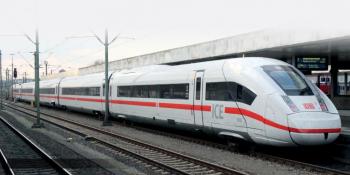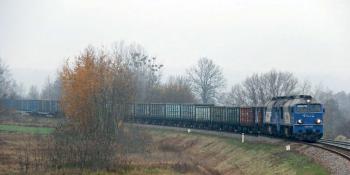EUROPE


EU REVIEWING SIEMENS ALSTOM MERGER
As we reported last month (p107), in mid-July the Commission of the European Union announced it would be undertaking a detailed review of the proposed Siemens Alstom merger. This followed a June deadline when the companies could have suggested possible changes to their plans to avoid an inquiry. Alstom obtained shareholder approval for the planned merger earlier in July, with 95% support for the plan.
The planned merger of Alstom with Siemens’ transport businesses was announced in September 2017, with support from both the French and German governments, with the intention of completing the deal by the end of 2018. This will now not happen, with mid-2019 the earliest likely date assuming the deal is approved by the EU; the outcome of the review will be published in late November.
The EU Competition Commissioner announced the review, saying there were concerns the new merged Siemens Alstom company would lead to higher prices for rolling stock (and therefore passengers) as the choice of suppliers would be restricted and the new merged company would be three times bigger than the next biggest European rival. The EU Commission also appears dismissive of the argument advanced by both Siemens and Alstom (supported by the French and German governments) that Chinese company CRRC would become a major competitor, with the EU Competition Commissioner saying the Commission did not believe the Chinese firm would enter the European market in the ‘near future’.
However, CRRC is already supplying EU-based customers on some small contracts. Its first hybrid shunting loco for DB Netze (last month, p98) will be on display in Berlin at InnoTrans in September. CRRC has also supplied locos and multiple-units to Serbia and Macedonia, and infrastructure wagons to London Underground. It has an order for EMUs from Czech open access operator Leo Express. CRCC has also been linked previously to reports of potential acquisitions of major EU rolling stock manufacturers in both Germany and Poland.
The current plans of Siemens and Alstom could be disrupted if the EU Commission decided to block or substantially amend the planned merger on competition grounds. It is possible that the merger may be permitted but with sale of parts of the business as a condition; ironically this would most likely be required in France and/or Germany – where the merged company would be by far the biggest rail engineering manufacturer – but where the political support from government is strongest in order to create a European champion to face up to future Chinese competition. If such disposals were required, CRRC is one of the obvious potential investors with the financial capability to actually undertake such a deal!
SIEMENS CHANGES CORPORATE STRUCTURE
Siemens has begun the process of carving out the activities of its former Mobility division (plus in some countries its electrical drives business unit) into discrete legal entities. The process has resulted in services previously shared across Siemens in a country being split up, with some roles transferring to the new Mobility company. By July Siemens had begun the process across its business with some countries such as Switzerland and the UK having completed the process. In the UK Siemens Mobility Ltd (owned by the new overall Siemens Mobility company based in Germany) now manages all the company’s British rail and signalling activities.
IMPROVED NUMBERS AT ALSTOM
Alstom announced increased new orders for the first quarter of 2018 (€2.6 billion compared to €1.9 billion for the same period in 2017) with revenue increasing by 14% from €1.8 billion to €2 billion in the same period. Alstom also announced major changes to its investment in Russian rail engineering company Transmashholding, which has merged with Russian engineering services firm Locotech. The combined Russian firm is now 20% owned by Alstom after the French company invested an additional €115 million in late June (Alstom had previously owned 33% of Transmashholding). The Russian government had in late April given Alstom approval for the inclusion of the Transmashholding stake in the proposed merger with Siemens.
Locotech was listed as the 139th of Russia’s 400 largest companies in 2015 and has contracts with Russian Railways (RZD) to maintain around 20,000 locos, having taken over 92 loco depots and 40,000 employees in 2014. Locotech also has a locomotive leasing business that is active in Russia and Europe; the company recently acquired the ex-British Rail Class 92s that DB Cargo had previously used in Romania and is now leasing them to Croatian logistics operator TransAgent.

CZECH REPUBLIC

REGIOJET WINS REGIONAL TENDER
Czech private operator Regiojet has won its first tender to operate regional services in the Czech Republic. The operator already operates open access long-distance services from Prague to Vienna, Bratislava and Košice, along with tendered regional services in Slovakia, where it has operated the Bratislava to Komárno route since March 2012.
The Czech tender Regiojet has won represents one million train kilometres annually on six routes in the area around the northern Czech city of Ústí nad Labem for 10 years from December 2019. Regiojet submitted the lowest subsidy bid (of 149 million Czech Crowns, so around 149 Czech Crowns per train kilometre). Local media reports suggest the Regiojet offer was around 50 Czech Crowns lower per train kilometre than the next lowest competing offer, with Czech national operator ČD, DB subsidiary Arriva and private operator Leo Express all also submitting offers for the contract.
As a quirk of previous EU-funded investment in new trains for the Ústí region, some services on the routes Regiojet will serve will continue to be operated by national operator ČD using the fleet of Škoda-built, EU-funded RegioPanter EMUs, which were bought specifically for services on the Litvínov to Ústí nad Labem and Děčín to Kadaň (via Ústí) routes in 2011. The services operated by the RegioPanter EMUs, which are owned by ČD, were not included in the tender for this reason.
The Ústí nad Labem regional government expects the new operator to use EMUs rather than the DMUs that current incumbent ČD uses for many services on the electrified network of routes served; the one short non-electrified line included in the tender will be electrified at 3kV DC (in common with the other lines) by national infrastructure manager SZDC by the end of 2019. Regiojet intends to obtain a fleet of seven new EMUs from Polish manufacturer Pesa to operate the contract.


FINLAND

GEARING UP FOR PASSENGER SERVICE LIBERALISATION
The Finnish government has embarked on changes to the domestic rail passenger market, partly driven by the EU Fourth Railway Package reforms. The country’s transport ministry and national operator VR (derived from the pre-1995 name Valtionrautatiet, or State Railways) have agreed a process that will see services opened to competition via tendering. The existing monopoly rights VR has for passenger services will be abolished gradually as tendering becomes the norm. It is anticipated that tendered services will be operating by the middle of 2022.
To ensure the market is actually contestable – the Finnish network uses 1,524mm gauge track not used anywhere else in the EU (the former Soviet Railways found in the Baltic States and in neighbouring Russia use 1,520mm gauge) – a rolling stock leasing company will be established. This will take ownership of the main regional EMU fleets (Classes Sm2 of 50x2-car EMUs, some stored, and Sm4 30x2-car units, all in use) used in southern Finland and subsequently will tender for new regional train fleets. The establishment of the leasing company is part of a wider restructuring planned for VR, which will see separate property and rolling stock maintenance businesses established – and then privatised – before 2022.
FRANCE

100 NEW HIGH-SPEED TRAINS
French national rail operator SNCF has placed an order with Alstom worth €2.7 billion for 100 new double deck high-speed trains. These will replace older single deck TGV trains, the oldest of which date from the early 1980s. The Nouveau TGV, as SNCF has described it, is part of the new Avelia range of high-speed trains offered by Alstom. The first order for these was placed by US operator Amtrak for the ‘Avelia Liberty’ trains that Alstom is currently building in the USA to replace the existing Acela trains on the North East Corridor (Washington DC – New York – Boston).
The French train, called the ‘Avelia Horizon’ by Alstom, is the result of partnership working between SNCF and Alstom, with over 2,000 people from both companies employed at one time or another, to develop a train that only costs €25 million per train (although this ‘design to cost’ headline number has only been achieved by assigning €190 million of the €2.7 billion total contract value to unspecified ‘options and services’). The cost of the new train compares favourably with the €30 million cost of the latest TGV Duplex trains, production of the last of which (Euroduplex Océane ordered between 2007 and 2017) will continue until 2020.
The first of the new Avelia Horizon trains will enter service in 2023 and deliveries will run for the following 10 years. The new train is designed to enable rapid internal reconfiguration with changes to new seating layouts possible in under one day. Some of the trains will be delivered in a higher density configuration able to accommodate up to 740 passengers, presumably for Ouigo low-cost services that currently use converted TGV Duplex units.
The articulated 350km/h trains will be formed of two compact 16-metre long power cars (four metres shorter than the current 20-metre TGV power cars) with nine intermediate double deck coaches. Alstom told Modern Railways the new SNCF trains will be equipped for operation from 25kV AC / 15kV AC / 3kV DC / 1.5kV DC traction supply. The addition of 15kV AC means operation in neighbouring Switzerland and Germany will be possible, whilst 3kV DC potentially enables operation into Belgium and Italy. Reduced operating and energy costs are built into the new trains’ design, with a more aerodynamic design compared to earlier TGVs and regenerative braking resulting in 20% lower energy consumption than the trains they will replace.

GERMANY

FREIGHT TRACK ACCESS
CHARGES CUT
The German government has made budget provision for nationwide reductions of up to 50% in freight train track access costs – first proposed in June 2017 as the key element in a ‘Masterplan for Rail Freight’ – with the reductions to apply from 2018 onwards. The plan also included funding for infrastructure expenditure to improve network capacity for freight, with provision for 740-metre freight trains also included.
The budget provision now presented to the German parliament means the reductions will not start before 2019 and will not be permanent, as previously assumed. They will apply until 2023 if judged to be ‘worthwhile’. The measure will cost €350 million in additional subsidy to rail infrastructure providers to cover the reduction in access charges paid by freight operators (the vast majority of this will go to national infrastructure manager DB Netze).
Both the Dutch and French governments have also announced similar plans to reduce freight train access charges on their networks in recent months. As the subsidy is from government, state aid clearance from the European Commission is required; the German government has notified the EU of its plans.
TAC REDUCTION – SAVIOUR FOR DB CARGO?
Announcing its half-year results for 2018, German national operator DB revealed its rail freight subsidiary DB Cargo increased its losses in the first half of 2018. Overall group revenue grew by 2.3% to €21.5 billion, but half-year profits were €205 million lower than for the first half of 2017 at €974 million. There was a loss of €127 million for the first six months of the year (compared to a loss of €28 million in the same period in 2017). Overall rail freight revenue was down 2.2% at €2.255 billion. DB has attributed the poor results to a mixture of the impact of the long-running strikes in France, bad weather and other (unspecified) internal problems. As the majority of its income comes from the German domestic market, it is apparent that much of the €127 million loss will be due to operations there.

DB Cargo has around 60% market share in Germany, so is the biggest single potential beneficiary from reduced track access charges. Interestingly, around 60% of the €350 million proposed extra track access subsidy would largely wipe out DB Cargo’s current losses.
CHANGED PRIORITIES?
The overall transport budget proposed by the new German government for 2019 to 2022 prioritises road building and maintenance over rail and will result in rail investment funds falling slightly from €5.7 billion to €5.6 billion annually in 2020 and plateauing thereafter. Expenditure on the national road network, however, will increase from €10.1 billion in 2018 to €12.2 billion by 2022.
BAVARIAN CONTRACT FOR GO-AHEAD
Go-Ahead has won its fourth operating contract in Germany and its first based in Bavaria. The 12-year contract to operate the Elektronetz Allgäu awarded by Bavarian transport authority BEG on the Munich – Buchloe – Memmingen – Hergatz – Lindau route will run from December 2021.
The contract represents around 2.6 million train kilometres annually and comprises semi-fast and stopping services operating on all or part of the route, which is currently being electrified at 15kV AC between Geltendorf (the current limit of Munich S-Bahn operation) and Lindau. The electrification work costing €440 million is running late and will not be completed until December 2021; originally it was due to be ready a year earlier.
In the interim DB Regio, the incumbent operator, will continue to operate services. The contract awarded by BEG requires Go-Ahead to take over those DB staff who previously operated the service; such staff transfers between operators due to contract gains/losses remain less common in Germany than elsewhere in Europe.
The electrification delay is in part caused by the requirement imposed by local planners to construct substantial noise barriers on much of the route that will be used by freight traffic from southern Germany heading for the Gotthard Base Tunnel, as well as passenger trains. The additional noise suppression measures are reported to have added €100 million to the project cost.
The contract has been let by BEG on a gross revenue basis so there is no revenue risk for the operator in the first years of the contract. Go-Ahead will order 22x4-car Flirt3 EMUs from Stadler to operate the services; BEG offered debt guarantees from the Bavarian state government to reduce the costs of financing new trains for the contract. Go-Ahead’s other German contracts are all centred on Stuttgart and all run from June 2019 to December 2032. They are:
■ Rems-Fils Netz Stuttgart – Crailsheim/Ulm;
■ Franken-Enz Netz – Stuttgart – Karlsruhe/Würzburg;
■ Murrbahn – Stuttgart – Nuremberg.

IRELAND

CROSS-BORDER DEVELOPMENT PLAN
Iarnród Éireann (IÉ) and Northern Irish operator Translink have launched an ambitious strategic development plan for the Cross-border ‘Enterprise’ service between Belfast and Dublin, ignoring ongoing political uncertainty around the nature of the post-Brexit border arrangements between Northern Ireland and the Republic. The launch of the plan on 8 June in Belfast was attended by the Chairs of both IÉ and Translink, plus the new IÉ CEO, Jim Meade.
‘Better Connecting Dublin and Belfast’ envisages the introduction of a new train fleet to allow an hourly service frequency within five years. Within the same time frame additional investment on infrastructure and line improvements would bring the journey time down to under two hours again – something that was achieved back in the early 2000s. In the longer term, electrification of the whole route and reduction of journey time to around 90 minutes is envisaged – it is believed this could be achieved in around 10 years.
Around one million passengers were carried on the ‘Enterprise’ services last year and it is believed the proposed improvements will increase modal shift toward rail transport.
The first steps for the development plan will be for operators on both sides of the border to secure the necessary funding to enable procurement of a new train fleet and to undertake technical and feasibility studies to assess the journey improvement options. Current bottlenecks for Enterprise services are in the Belfast suburban area and operating on the two-track railway behind frequent DART services coming out of Dublin. Tim Casterton
SWEDEN

CROSS-CITY LINE FOR GOTHENBURG
Construction work has begun in Gothenburg for the new underground 8km-long Västlänken (West Link) line that will enable regional services from the north or east of the city to operate through Gothenburg. This will serve a new underground station under the existing main terminus station (which will be retained but reduced in size for long-distance traffic) and two more new underground city centre stations before heading south. The new line is due to open in 2026.
Meanwhile, Västtrafik, the public transport authority for the Gothenburg region, has awarded Bombardier a SKR3.8 billion (L330 million) contract to supply 40x3-car 200km/h regional EMUs to replace older trains and increase service levels and capacity in the future. The first of the new 80-metre long, 270-seat, 15kV AC trains will be delivered from Bombardier’s German factories in 2021. Västtrafik acts as service specifier and rolling stock provider and contracts operation of its rail services, currently in a contract that runs to 2024 with national operator SJ via its SJ Götalandstag subsidiary.
UKRAINE

BESKYD TUNNEL OPEN
The new 1.822km Beskyd tunnel on the main line between the Ukrainian city of Lviv and the border with Hungary and Slovakia at Chop opened in late May. The double-track single-bore tunnel, at points as much as 180 metres under the Carpathian Mountains, was built using the New Austrian Tunnelling method (excavation by miners, with concrete sprayed to maintain the initial raw bore before lining with finished concrete).
The new tunnel is parallel to the original 1.75km-long single track tunnel dating back to 1886, which had become a serious bottleneck for the line from Chop to Lviv. This is the principal rail freight route between the EU and Ukraine. The old tunnel will be converted into an emergency access/rescue tunnel for the new one, with three cross passages between the two.
The tunnel cost €163 million, a third of which was funded by Ukrainian Railways. The rest was funded by loans from the European Investment Bank and the European Bank for Reconstruction and Development.




